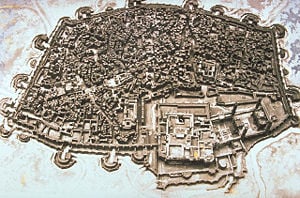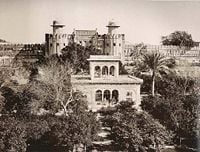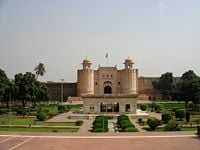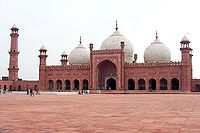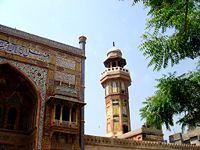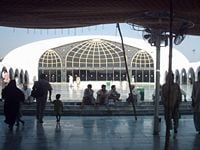Difference between revisions of "Walled City of Lahore" - New World Encyclopedia
Dan Davies (talk | contribs) (→External links: links checked) |
Dan Davies (talk | contribs) (→References: added) |
||
| Line 159: | Line 159: | ||
==References== | ==References== | ||
| + | * Anwar, Ajaz. 1996. Old Lahore. Lahore: A. Anwar. OCLC 38303956. | ||
| + | * Goulding, Henry Raynor, and T. H. Thornton. 2006. Old Lahore: reminiscences of a resident. Lahore: Sang-e-Meel Publications. ISBN 9789693518740. | ||
| + | * Hankey, Donald. 1994. Conservation of the walled city: case study : Lahore, Pakistan. Washington, D.C.: South Asia Infrastructure Sector Unit, World Bank. OCLC 49938923. | ||
| + | * Lahore Museum (Pakistan). 2006. Masterpieces of Lahore museum. Lahore: Lahore Museum ; in collaboration with. OCLC 137232699. | ||
| + | * Nadiem, Ihsan H. 2006. Historic landmarks of Lahore: an account of protected monuments. Lahore: Sang-E-Meel Publications. ISBN 9789693518696. | ||
| + | * Pakistan Environmental Planning & Architectural Consultants, and Metropolitan Planning Wing (Lahore Development Authority). 1988. Monograph, the walled city of Lahore, Pakistan. [Lahore]: Metropolitan Planning Section, Lahore Development Authority. OCLC 40141045. | ||
| + | * Pakistan Environmental Planning & Architectural Consultants, and Lahore Development Authority. 1993. The Walled city of Lahore. [Lahore]: Lahore Development Authority. OCLC 31900997. | ||
| + | * Warren, D. 2003. "Lahore; or, the Islamic Gale". COMMENTARY -NEW YORK- AMERICAN JEWISH COMMITTEE-. 115: 33-39. OCLC 203725103. | ||
| + | * Weiss, Anita M. 1992. Walls within walls: life histories of working women in the old city of Lahore. Boulder: Westview Press. ISBN 9780813384221. | ||
| + | * Quraeshi, Samina, and Annemarie Schimmel. 1988. Lahore: the city within. [Singapore]: Concept Media. OCLC 20589073. | ||
== External links == | == External links == | ||
Revision as of 02:21, 17 June 2008
The Walled City of Lahore, also known as the "Old City," or "Anderoon Shehr (اندرون شهر)," is the section of Lahore, Punjab, Pakistan that was fortified by a city wall during the Mughal era.
Origins of Walled City of Lahore
Our search for the origins of the original Lahore has immense twists and turns. It's time period can be anything starting 2,000 B.C.E. onwards... at least carbon dating evidence of archaeological findings in the Lahore Fort do suggest this time period.
We learn from various sources that Lahore had many names, all of which changed over time. But the one name that does warrant research is 'kacha kot'.
One of the two most probably sites of the 'original' Lahore is Mohallah Maulian. Let us explore this area in this brief piece. If we focus on Sootar Mandi - the yarn market - inside Lohari Gate, we can get a feel of what we are looking for. Sootar Mandi was once called Mohallah Chaileywala Hammam, and is located in what was once called Machli Hatta Gulzar, which is just off Chowk Chalka, Lahore's original red-light area.
As late as 1864, according to one source quoting Mufti Tajuddin, son of the well- known Mufti Imamuddin, the Lohari Mandi area was known among the old folk of the Walled City as 'kacha kot' - the mud fort. Why was this area called a 'mud fort' when we know that the original walls of the Lahore Fort, before Akbar the Great's days, were also made of mud? This is the question that must be explored.
To determine this it is important that one visits the old Walled City, observe the gradient of the land, the water (nullah's act as excellent guides of gradient and direction) flow and observe how 'mohallahs' and 'kuchas' and 'kattrahs' are structured.Standing at Chowk Sootar Mandi, if you observe the curve of Gali Pir Bola as it merges with Waachowali Bazaar, and then also the Lohari Bazaar where it merges with Chowk Lohari Mandi, and, lastly, where Chowk Mati where it merges with Papar Mandi, you can well imagine. If you close your eyes and transport yourself 3,500 years back, a small mud fort with a small dwelling. The setting is perfect. Once you open your eyes, it is time to observe, or look for, some evidence of a mud fort.
If you walk along Lohari Bazaar, just a short distance from Chowk Chakla (Imagine, this beautiful name has been changed to a pious Chowk Bokhari!) to the right you will see the street open a little, for on the right is a half-buried archway of 'pucca' bricks and mud. Could this be from the era when Lahore was a mud fort? The evidence certainly does suggest that this could be an archway, or gateway, of the small original 'kacha kot' way back in time, a place that was to grow one day to become Lahore.
It is also possible, for we must not exclude any possibility, that this was the famous mud fort that was built by Malik Ayaz, the very first Muslim governor of Lahore. This is very probably because it is recorded history that Lohari Gate was the main entrance to Ayaz's mud fort. So no matter how you analyze recorded evidence, one thing is for sure, and that is that Chowk Sootar Mandi was one important centre of Kacha Kot. The lay of the streets also suggest the boundaries.
In an earlier piece we had followed a similar theory, and come up with the proposition that during the times of Mughal Emperor Akbar, the original wall of the Walled City of Lahore was, on the western side, to the right of Bazaar Hakeeman in Bhati Gate, and on the eastern side to the left of Shahalam Gate, which then curved eastwards and formed a 'kidney shaped' city that depended on the flow of the curving River Ravi. Thus the Lahore of the 'kacha kot' era has continued to expand in three major leaps of expansion, each with an almost 400-year gap. The eras of Raja Jaipal of Akbar and of Maharajah Ranjit Singh mark the high points of this expansion.
But the expanding bubble definitely has its origins in three factors, they being (a) the way the Ravi has flown and how and when it has been changing its course, (b) the existence of the Lahore Fort and how power has flowed from the rulers, and (c) the manner in which the population and economy of the old original Walled City has changed over time, grown, or even shrunk, depending of invasions, droughts and famines in the countryside. The story of 'kacha kot' has been determined by these factors.
When walking through these streets, it is not hard to make out that the oldest buildings in the entire Walled City exist in this area. As one passes the old exquisite mosque known even now as Masjid Kohana Hammam Chaileywala, one is reminded that the area was named similarly once. There must have been a huge 'hammam' here once. The tomb of Pir Bola exists after which is named the 'gali'.
It is sad that we tend to change the names of streets and areas, and even cities, at the drop of a hat as if to stamp some sort of moral authority on time. All rulers love to block out history. It would be best to let history rest and emerge as times dictate. It would not be a bad idea to declare the entire Walled City as a protected area. Let us keep for the future the little that is left of 'kacha kot' - the mud fort that ultimately became the Walled City of Lahore.
Demographics
The Walled City of Lahore covers an area of 256 ha with a population of 200,000. The city walls were destroyed shortly after the British annexed the Punjab in 1849 and were replaced with gardens, some of which exist today. The Circular Road links the old city to the urban network. Access to the Walled City is still gained through the 13 ancient gates, or their emplacements. The convoluted and picturesque streets of the inner city remain almost intact but the rapid demolition and frequently illegal rebuilding, which is taking place throughout the city, is causing the historic fabric to be eroded and replaced by inferior constructions. Historic buildings are no exception and some have been encroached upon. The few old houses one can still see in the city are usually two or three storeys tall, with brick façades, flat roofs and richly carved wooden balconies and overhanging windows.
Gates of Lahore
Walled City of Lahore had 13 gates which included ; Akbari Gate, Bhati Gate, Delhi Gate, Kashmiri Gate, Lohari Gate, Masti Gate, Mochi Gate, Mori Gate, Roshnai Gate, Shahalmi Gate, Shairanwala Gate, Taxali Gate, and Yakki Gate. All of these gates survived till 19th Century when the British, to derfortify the city, demolished almost all of the gates except Roshnai Gate. After that some were rebuilt except for Delhi Gate and Lohari Gate in simple structures. Shahalmi Gate was burnt to ground during the roits of 1947 while Akbari Gate was also demolished for repairs but was never built again . Today out of 13 only 6 gates survives which are ; Bhati Gate, Delhi Gate, Kashmiri Gate, Lohari Gate, Roshnai Gate and Shairanwala Gate.some of these gates are in pretty poor state and need urgent attention for repairs and restoration.
Surviving Gates
| Name | Picture | Description |
|---|---|---|
| Bhati Gate | 200px | The entrance to the "Bhati Gate" is located on the western wall of the old city. The area inside the gate is well known throughout the city for its food. Just outside of "Bhati Gate" is the Data Durbar, the mausoleum of the Sufi saint Ali Hajweri (also known as Data Sahib Ganjbaksh). Every Thursday evening Naat Readers and Qawawals (who perform Qawwali) gather here to read Naat and perform religious Qawwali. |
| Delhi Gate | 200px | The "Delhi Gate" was once the main and only road that led from Lahore to Delhi. The gate was built during the Mughal era. Although the gate suffered greatly in the riots during independence, it has since been renovated and today is in its former glory. |
| Kashmiri Gate | 200px | The "Kashmiri Gate" is so named because it faces the direction of Kashmir. Inside the gate there is a shopping area called "Kashmiri Bazaar" and a beautiful girl's college. This college, built upon an old haveli belonging to a shah, is a beautiful example of Mughal architecture. |
| Lohari Gate | 200px | The "Lohari Gate" is very close to "Bhati Gate" and it was built, like many other gates, to keep enemies out. Although nowadays it is surrounded by shops and stalls, it still has great architectural significance. In Urdu "loha" means "iron" and the gate is named Lohari because many lohars (blacksmiths) workshops were based just outside this gate. |
| Roshnai Gate | 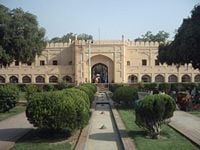
|
The "Roshnai Gate," also known as the "Gate of Lights," is located between the Lahore Fort and the Badshahi Mosque. As the gate was one of the main entrances into the city, it was constantly visited by Omerahs, courtiers, royal servants and retinues. In the evenings the gate was lit up, hence its name. The gate was also referred to as the "Gate of Splendour." It is the only gate that is in good condition and still retains its original looks. |
| Shairanwala Gate | 200px | The "Shairanwala Gate," also known as the "gate of the lions," was made by Maharaja Ranjit Singh. After its completion, Singh placed two live lions (or Shers) in cages at the gate as a symbolic gesture to warn any invader. |
Gates that no longer exist
| Name | Description |
|---|---|
| Akbari Gate | The "Akbari Gate" is named after the great Mughal emperor Akbar, who rebuilt the town and citadel. Close to this gate the Emperor also founded a market, which is named after him: "Akbari Mandi." (Akbari Market) |
| Masti Gate | Just behind the Lahore Fort is the "Masti Gate" entrance. This area is dominated by wholesale shoesellers who sell both traditional- and Western-style shoes. Located further down the street is one of the city's oldest mosques, the Mosque of Mariyam Zamani Begum, named after the mother of Jahangir, Mariyam Zamani. |
| Mochi Gate | Located at the entrance to Mochi Bagh (garden) and amidst a bustling bazaar (market), the "Mochi Gate" is a historical gate built during the Mughal period. In Urdu "Mochi" means cobbler which may indicate that the bazaar was once a market for shoes and repair shops.
Another theory is that according to legend the gate was named after Moti, a guard of the gate during the Mughal era, who guarded and looked after the gate all his life. Later on, the name was distorted and became Mochi. Nowadays the bazaar around the Mochi gate is renowned for its dry fruits, kites and fireworks. Mochi gate is the entrance to the Mochi Bagh, where many renowned Pakistani leaders of past and present have delivered speeches. |
| Mori Gate | Located between the Lohari Gate and Bhati Gate, the "Mori Gate" is the smallest of the gates of the walled city. This gate was used to remove the waste and disposal material from the city.
Mori Gate was never considered an official gate, but the residents of Lahore considered it to be the 13th gate. |
| Shahalmi Gate | The "Shahalmi Gate" is named after the one of the sons of the Mughal emperor Aurangzeb, Shah Alam I. However, before his death the gate was called the "Bherwala Gate." During independence the gate was burnt so today only the name survives.
One of Lahore's biggest commercial markets, "Shah Alam Market," exists near the site of the gate. |
| Tixali Gate | The "Tixali Gate," also known as the Tixal (royal mint), was built during the Mughal reign. There is a very famous shoe market located here known as Sheikupurian Bazar. There are a variety of tasty foods available in and around this gate - one of the most beloved being Sri Pai from Fazal Din aka "Phajja." Among sweet stores Taj Mehal and Shahbudin Halwi are popular. |
| Yakki Gate | The "Yakki Gate" was named after the martyr saint "Zakki." Zakki fell while defending the city against the Mughal invaders from the north. Over time the name "Zakki" became distorted to what the gate is known as today: "Yakki." |
Sites of Interest
Lahore Fort
The Lahore Fort, locally referred to as Shahi Qila citadel of the city of Lahore, Punjab, Pakistan. It is located in the northwestern corner of Lahore, adjacent to the Walled City. Some of the famous sites within the fort are: Sheesh Mahal, Alamgiri Gate, Naulakha pavilion, and Moti Masjid. The fort is 1,400 feet long and 1,115 feet wide. In 1981, the fort was inscribed as a UNESCO World Heritage Site along with the Shalamar Gardens.
Mosques
Badshahi Mosque
The Badshahi Mosque (Urdu: بادشاھی مسجد), or the 'Emperor's Mosque', was built in 1673 by the Mughal Emperor Aurangzeb in Lahore, Pakistan. It is one of the city's best known landmarks, and a major tourist attraction epitomising the beauty and grandeur of the Mughal era.
Capable of accommodating over 55,000 worshippers, it is the second largest mosque in Pakistan, after the Faisal Mosque in Islamabad. The architecture and design of the Badshahi Masjid is closely related to the Jama Masjid in Delhi, India, which was built in 1648 by Aurangzeb's father and predecessor, emperor Shah Jahan.
Wazir Khan Mosque
The Wazir Khan Mosque in Lahore, Pakistan, is famous for its extensive faience tile work. It has been described as ' a mole on the cheek of Lahore'. It was built in seven years, starting around 1634-1635 C.E., during the reign of the Mughal Emperor Shah Jehan. It was built by Shaikh Ilm-ud-din Ansari, a native of Chiniot, who rose to be the court physician to Shah Jahan and later, the Governor of Lahore. He was commonly known as Wazir Khan. (The word wazir means 'minister' in Urdu language.) The mosque is located inside the Inner City and is easiest accessed from Delhi Gate.
Data Durbar Complex
Data Durbar is the tomb of Hazrat Syed Abul Hassan Bin Usman Bin Ali Al-Hajweri, the famous Sufi saint of South Asia, where hundreds of thousands of people come each year to pay their respects and to say their prayers. It is located in Lahore, Punjab, Pakistan. The large complex also includes Jamia Hajveria, or Hajveri Mosque.
Others
other well known mosques inside the walled city are Suneri Mosque , Mosque of Mariyam Zamani Begum,Doongi Mosque. despite these there are many more historic mosques located inside the walled city of lahore
Haveli
There are many havelis inside the walled city of lahore some are in good condition while other need urgent attention. many of these havlis are fine example of Mughal and Sikh Architecture.Some of the Famous Havelis inside the walled city are
- Mubarak Haveli
- Chuna Mandi Havelis
- Haveli of Nau Nihal Singh
Other Landmarks
- Shahi Hamam
- Smadhi of Ranjit Singh
- Tomb of Malik Ayaz
Restorations And Conservation Projects
- The Punjab government is also working on restoring the Royal Trail (Shahi Guzar Gah) from Akbari Gate to the Lahore Fort with the help of World Bank under the Sustainable Development of the Walled City of Lahore (SDWCL) project. The project aims at the Walled City development, at exploring and highlighting economic potential of the Walled City as a cultural heritage, exploring and highlighting the benefits of the SWDCL project for the residents, and at soliciting suggestions regarding maintenance of development and conservation of the Walled City.
See also
- Lahore
- Lahore Fort
- Badshahi Mosque
ReferencesISBN links support NWE through referral fees
- Anwar, Ajaz. 1996. Old Lahore. Lahore: A. Anwar. OCLC 38303956.
- Goulding, Henry Raynor, and T. H. Thornton. 2006. Old Lahore: reminiscences of a resident. Lahore: Sang-e-Meel Publications. ISBN 9789693518740.
- Hankey, Donald. 1994. Conservation of the walled city: case study : Lahore, Pakistan. Washington, D.C.: South Asia Infrastructure Sector Unit, World Bank. OCLC 49938923.
- Lahore Museum (Pakistan). 2006. Masterpieces of Lahore museum. Lahore: Lahore Museum ; in collaboration with. OCLC 137232699.
- Nadiem, Ihsan H. 2006. Historic landmarks of Lahore: an account of protected monuments. Lahore: Sang-E-Meel Publications. ISBN 9789693518696.
- Pakistan Environmental Planning & Architectural Consultants, and Metropolitan Planning Wing (Lahore Development Authority). 1988. Monograph, the walled city of Lahore, Pakistan. [Lahore]: Metropolitan Planning Section, Lahore Development Authority. OCLC 40141045.
- Pakistan Environmental Planning & Architectural Consultants, and Lahore Development Authority. 1993. The Walled city of Lahore. [Lahore]: Lahore Development Authority. OCLC 31900997.
- Warren, D. 2003. "Lahore; or, the Islamic Gale". COMMENTARY -NEW YORK- AMERICAN JEWISH COMMITTEE-. 115: 33-39. OCLC 203725103.
- Weiss, Anita M. 1992. Walls within walls: life histories of working women in the old city of Lahore. Boulder: Westview Press. ISBN 9780813384221.
- Quraeshi, Samina, and Annemarie Schimmel. 1988. Lahore: the city within. [Singapore]: Concept Media. OCLC 20589073.
External links
- Walled City Has thirteen gates. Retrieved June 17, 2008.
- Information about the gates & history. Retrieved June 17, 2008.
- Attractions of Lahore. Retrieved June 17, 2008.
- Places to See: The gates of Lahore. Retrieved June 17, 2008.
- Aerial Map of Lahore on WikiMapia.org. Retrieved June 17, 2008.
Credits
New World Encyclopedia writers and editors rewrote and completed the Wikipedia article in accordance with New World Encyclopedia standards. This article abides by terms of the Creative Commons CC-by-sa 3.0 License (CC-by-sa), which may be used and disseminated with proper attribution. Credit is due under the terms of this license that can reference both the New World Encyclopedia contributors and the selfless volunteer contributors of the Wikimedia Foundation. To cite this article click here for a list of acceptable citing formats.The history of earlier contributions by wikipedians is accessible to researchers here:
The history of this article since it was imported to New World Encyclopedia:
Note: Some restrictions may apply to use of individual images which are separately licensed.
